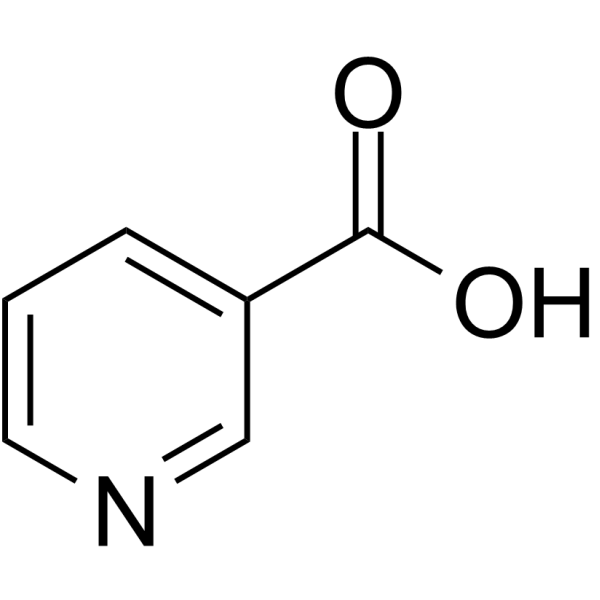Home
Products
Nicotinic acid



| Product Name | Nicotinic acid |
| Price: | $12 / 20mg |
| Catalog No.: | CN00075 |
| CAS No.: | 59-67-6 |
| Molecular Formula: | C6H5NO2 |
| Molecular Weight: | 123.11 g/mol |
| Purity: | >=98% |
| Type of Compound: | Alkaloids |
| Physical Desc.: | Powder |
| Source: | |
| Solvent: | Chloroform, Dichloromethane, Ethyl Acetate, DMSO, Acetone, etc. |
| SMILES: | OC(=O)c1cccnc1 |
| Contact us | |
|---|---|
| First Name: | |
| Last Name: | |
| E-mail: | |
| Question: | |
| Description | Niacin (Vitamin B3) is a water-soluble vitamin and is part of the vitamin B group.Target: OthersNiacin (also known as vitamin B3 and nicotinic acid) is an organic compound with the formula C6H5NO2 and, depending on the definition used, one of the 20 to 80 essential human nutrients. Not enough niacin in the diet can cause nausea, skin and mouth lesions, anemia, headaches, and tiredness. Chronic Niacin deficiency leads to a disease called pellagra. The lack of niacin may also be observed in pandemic deficiency disease which is caused by a lack of five crucial vitamins: niacin,vitamin C, thiamin, vitamin D and vitamin A, and is usually found in areas of widespread poverty and malnutrition.Niacin has been used for over 50 years to increase levels of HDL in the blood and has been found to decrease the risk of cardiovascular events modestly in a number of controlled human trials. Niacin cannot be directly converted to nicotinamide, but both compounds could be converted to and are precursors of NAD and NADP in vivo.Nicotinic acid, nicotinamide, and tryptophan (via quinoline acid) are co-factors for nicotinamide adenine dinucleotide (NAD) and nicotinamide adenine dinucleotide phosphate (NADP). NAD converts to NADP by phosphorylation in the presence of the enzyme NAD+ kinase. NADP and NAD are coenzyme for many dehydrogenases, participating in many hydrogen transfer processes. NAD is important in catabolism of fat, carbohydrate, protein, and alcohol, as well as cell signaling and DNA repair, and NADP mostly in anabolism reactions such as fatty acid and cholesterol synthesis.High energy requirements (brain) or high turnover rate (gut, skin) organs are usually the most susceptible to their deficiency. |
| Target | Human Endogenous Metabolite |
| Density | 1.473 |
| Boiling Point | 292.5±13.0 °C at 760 mmHg |
| Flash Point | 130.7±19.8 °C |
| PSA | 55.98000 |
| LogP | 0.15 |
| Vapour Pressure | 0.0±0.6 mmHg at 25°C |
| Storage condition | 0-6°C |